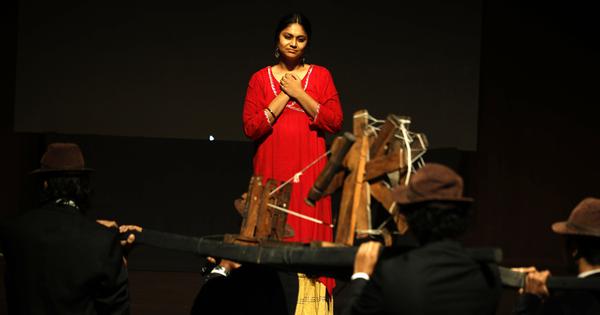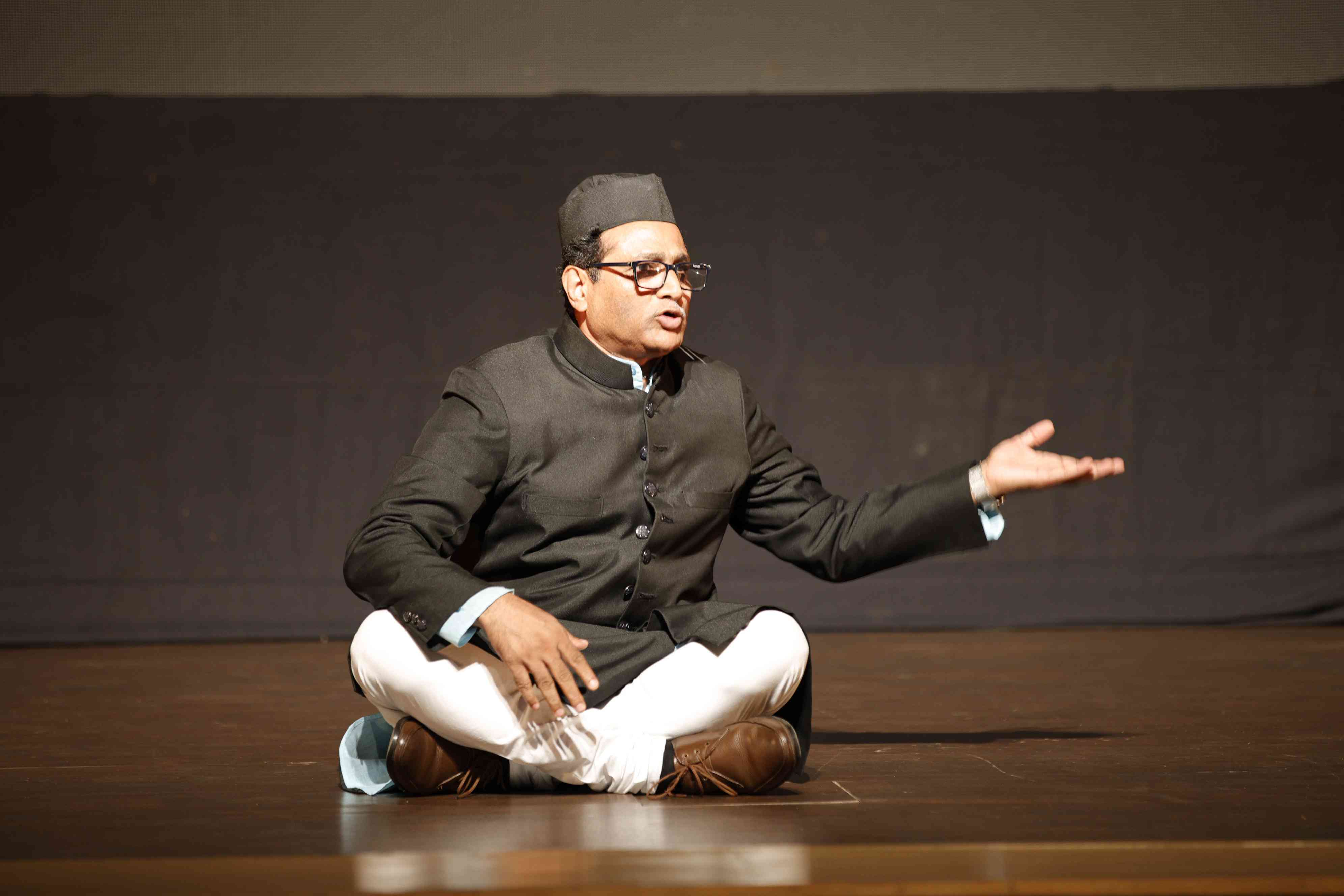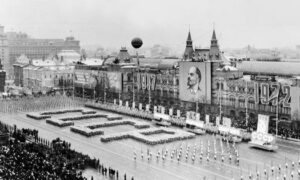
Supported by the colonial British-Indian administration, American Historian Katherine Mayo wrote her best-known work, Mother India in 1927. The book tried to fix India’s image in a single damning frame. Mayo argued forcefully that Indians were not worthy of autonomy because of abominable treatment of women and best served by colonialism’s civilising influence. It created a furore in Indian publics and they responded with prolific rebuttals in print, art and politics creating a long-standing debate on what Mother India is and is not.
Understandably, an important strand in this debate would seek to reimagine Mother India in a way which made her a moral figure, and Indians, worthy of freedom.
Being an intensely political writer, filmmaker, journalist and cultural commentator, Khwaja Ahmed Abbas must have been conscious of the contours of this debate when he wrote Bharat Mata ke Paanch Roop. It was first published in 1959 in a volume of short stories titled Diya Jale Saari Raat. In the story, Abbas may not be responding to Mayo’s polemical Mother India directly but he replaced the singular, majoritarian, divine “Mother” with five ordinary-yet-exemplary women.
He uses description of their everyday courage to give content to the idea of India as an ethical collective, and thus, Indians as deserving of autonomy.
Kaun Hai Bharat Mata, a stage adaptation of the story by Mandala Theatre Group performed on September 2 tapped this alternative reimagination of patriotism of KA Abbas with verve and warmth. The production was supported by IPTA, Rajiv Gandhi Foundation and Khwaja Ahmed Abbas Memorial Trust.
Staged at Delhi’s Jawahar Bhawan auditorium – hardly a purpose-built theatre – the production could easily have been hamstrung by limitations of the space. But it wasn’t. Despite heavy rain in the city the auditorium was full. Clean sightlines and unconventional entries of several actors from among the audience made the space work well.
The use of a digital screen on the stage was jarring in the beginning but turned out to be effective for a minimalist set. The projected visuals authenticated the context. A central screen provided a living archive: grainy archival newsreel, fragments from films and TV shows, artworks stitched together transitions and highlighted the subtext without too much moralising.
Each of the five sketches was delivered as a story narration but the actors infused it with the entire lifeworlds of the protagonists through lively speech rhythms and expansive stage work. The tone of each of the sketch was varied and the performances were notably polished. Moments of solo narration and quiet reflection were offset by imaginative transitions. The music, sometimes recorded played and live singing, was often carrying emotion across scene changes. It was consistently engaging but sometimes overpowered actor speeches.
Even in a hall not exactly designed for professional theatre performances, the cast’s projection and timing kept the back rows involved. Applause punctuated key points in the play, and, at more than one point, the audience joined with the actors’ slogans and songs.
The theatre adaptation of Abbas’s memoire-story by Lokesh Jain was creative yet faithful to Abbas’s core spirit. The five women narrated by women and men actors produced a complex gendered field on the stage, which reflected the paradox and need of Indian feminism to distinguish itself from western feminism as an anti-colonial move at the time.
Gandhi figures prominently in Abbas’ narrative and in the play through Masood Hussain’s artworks in the play. But the play was fairly successful in depicting Gandhi as a value in the moral universe of these civic mothers and not as a cult of personality.
Mohammad Kazim’s narration of a multilingual household in Madras was delightful and Pakhi Jain made the story of old Hakeemat weaving a khadi shroud radiate with her youthful perspective. Chhavi almost became the refugee Maaji from Rawalpindi.
The only character among the five who is not a Gandhian or pacifist is a Maharashtrian Brahmin whose will to provide cover to her grandson Inquilabi’s friends involves breaking caste strictures. Rajesh Tiwari made valiant effort to infuse Nani’s story with satirical humour.
Director Lokesh Jain became the voice of KA Abbas and narrates the story of his mother – a Muslim woman who was displaced from her beloved Panipat in the Partition violence but still refuses to move to Pakistan.
The vignettes foreground choices that make these women appear as a cut above and against the grain. In Abbas’s telling these mothers are ordinary, but for their extraordinary response to exceptional circumstances. His civic mothers dethrone a divine icon, thus reimagining Mother India characterised by practicable set of ethics.
They are seen setting aside regional parochialism, ridding themselves of deeply ingrained caste prejudice, risking financial security, favouring the political over familial bonds – in order to inhabit a plural, capacious India. Their virtues involve tethering courage, self-discipline and labour to solidarity and fraternity. These biographies were able to remind the audience what citizenship means in the best possible sense, which was perhaps the intention of Abbas when he penned them.
History pulsates through the play. The Non-Co-operation and Khilafat movements are the moments in which political judgment is formed by the five mothers. The choices made by Lokesh Jain meant that the audience confront the Partition as a wound. But they are not left only hurting. The contemplation of the pain helped me understand that the Partition was also experienced by its survivors as a test of moral principles in face of a violent political vision.
I saw the book Five Faces of Mother India with an introduction and translation by Sayeda Hameed published by Pratham at a book display and sale table outside the theatre only after the performance. As a result the intertextuality created by projection of the book illustrations by Nilofer Wadia elided me during the performance. But the artwork matched the prose’s clarity.
Many years ago I had seen artist Savi Savarkar’s striking work critiquing caste imagination in the Manusmriti. Used in Inquilabi Nani’s story it is a brilliant example of how art can disturb normative ways of understanding.
The show was entertaining in the best sense. The music and video coordination by Akhil and Madhur was pacey, melodic and emotionally legible. Even when its entertainment slipped into sentimentality it still made the audience feel the loss of values and encourage to value anew like the use of quranic verses when Gandhian khadi weaver Hakku dies.
If a couple of sections felt overtly oratorical, the production earns them with careful build-up and a quick return to lived detail. The closing minutes of the sketches left the hall audibly moved.

This review would be incomplete without mentioning the ethical architecture the play seeks to bring into the spotlight. In the Gandhian tradition, nationalism is not primarily a question of whether the agents who colonise our lifeworld are foreign or native; it is a question of morality and autonomy. Satyagraha, is, in that frame, a method for reconstituting the self, the neighbourhood, and the polity by refusing domination and cultivating mutual aid. This necessarily means quiet courage for standing up for other’s freedom too.
None of this can be achieved by jingoistic sloganeering, so steering clear of that would be a requirement too.
A professional cast in an under-equipped hall appeared before a parched audience ready to soak in stories of composite culture. That night Bharat Mata morphed from being an idol to be defended with aggression and came alive as civic mothers whose imagination was marked by faith in humanity. Five Faces of Mother India offers a calm grammar of belonging against the frenzied circulation of mythic nationhood that alienates.
Once or twice an individual in the audience broke into slogans that resonated with the feared jingoism too and many joined in with the person as if there was no option but to. But some were startled too, and others reacted with now familiar, fatigued dismay.
I hope I am not over estimating the atmosphere in the theatre, but the active spectatorship of the audience in Jawahar Bhawan could indicate a hunger for a civic, inclusive nationalism that many of us experienced not too long ago, and miss sorely. The play made one hopeful that perhaps others may not have forgotten it too because this civic feeling appeared familiar too. And perhaps has a more enduring appeal than we give it credit for.
Ghazala Jamil is an Assistant Professor at the Centre for the Study of Law and Governance, Jawaharlal Nehru University.
This article first appeared on Scroll.in
📰 Crime Today News is proudly sponsored by DRYFRUIT & CO – A Brand by eFabby Global LLC
Design & Developed by Yes Mom Hosting






